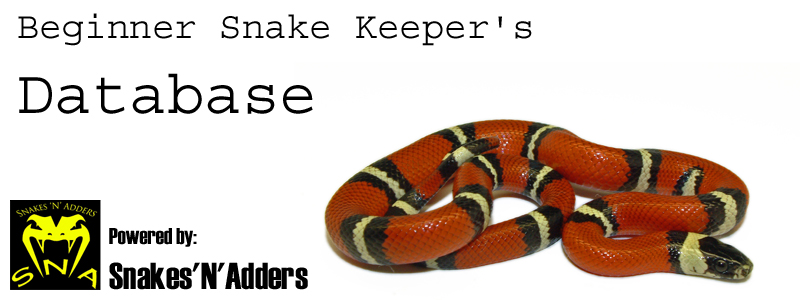
Thermostats:
Quite possibly the single most important piece of equipment needed for a snake after the enclosure itself. This is the controller of the environment you want to create. This is not a thermometer (which can only read temperature and not give the keeper any way to manipulate things if they are wrong). Decades ago we had to muddle through without these safety nets and we will have lost untold scores of animals as a result. Understanding about the way animals live is always developing and over the last decade alone the advancements in thermostatic control have been little short of staggering. A digital revolution has begun. Greater control and greater levels and stages of manipulation over a 24 hour period are now possible than ever before. Here you are guided through the basic forms of thermostatic control.
On/Off Thermostatic Control:
The most rudimentary way of controlling animals enclosure. Peak power is either engaged or it is off. There is no in between. If this type of controller is to be used due to budget constraints or otherwise it must only be used with temperate species.
• This type of controller is not for species occurring within the tropics.
• This type of controller must only be used with non-light emitting heat sources.
Expect a varying temperature. If the desired temperature is for example 30°c expect a peak of 32-33°c and a trough of 27-28°c. This is unavoidable due to the control systems on/off power supply. If we can create a median temperature at the desired 30°c this is a best case scenario.
Pulse-Proportional Control:
A great level of control and accuracy is achieved with this type of controller. Pulses of varying wattage over various periods of time (1 second, 2 seconds, 3 seconds etc) means the thermostat assesses and revisit enclosure temperatures more regularly than the on/off type controller.
• This type of controller can be used to maintain the environment of any snake species regardless of bandwidth.
• This type of controller must only be used with non-light emitting heat sources.
Expect a relatively stable temperature once up to heat and running. Usually within 1>1.5°c of the desired temperature. In stable reptile rooms potentially even more accurate.
Dimming Control:
This type of thermostat offers the greatest level of control and accuracy. This thermostat is almost constantly assessing the internal environment to make sure desired temperature and actual temperature are as close as possible.
• This type of controller can be used to maintain the environment of any snake species regardless of bandwidth.
• This type of controller can be used with any heat sources.
Expect a stable temperature once up to heat and running. Usually within 1°c of the desired temperature. In stable reptile rooms potentially even more accurate.
Initial Setup:
In every case when the thermostat is turned on for the first time in a ‘cold’ vivarium the user can expect a volatile first few hours trying to get the temperature to stabilize. As the décor and equipment heats through they absorb heat energy. Once up to temperature and charged up they begin to radiate heat as well. This can throw thermostats out and many times people can be fooled into thinking they have the vivarium set to temperature after an hour or so for it to spike once again. Be patient, it will calm down. The snake should not be in the enclosure during this period.
Day/Night Cycle:
An animal’s circadian rhythm can play an important part in encouraging animals to breed. Keepers can opt to keep their snake at constant single temperatures at the hot end but much more preferable is to offer the natural day time high and night time low. These often times are marketed as Day/Night Thermostats.
Depending on the manufacturer the mechanism for deciding whether it is day or night differs. Some are triggers by ambient light levels using a lux meter (the sensitivity of which can be turned up or down). Some are triggered by using ancillary mechanical timer plugs and then some are now fully digital solutions relying on the accuracy of an on board quartz crystal and clock system.
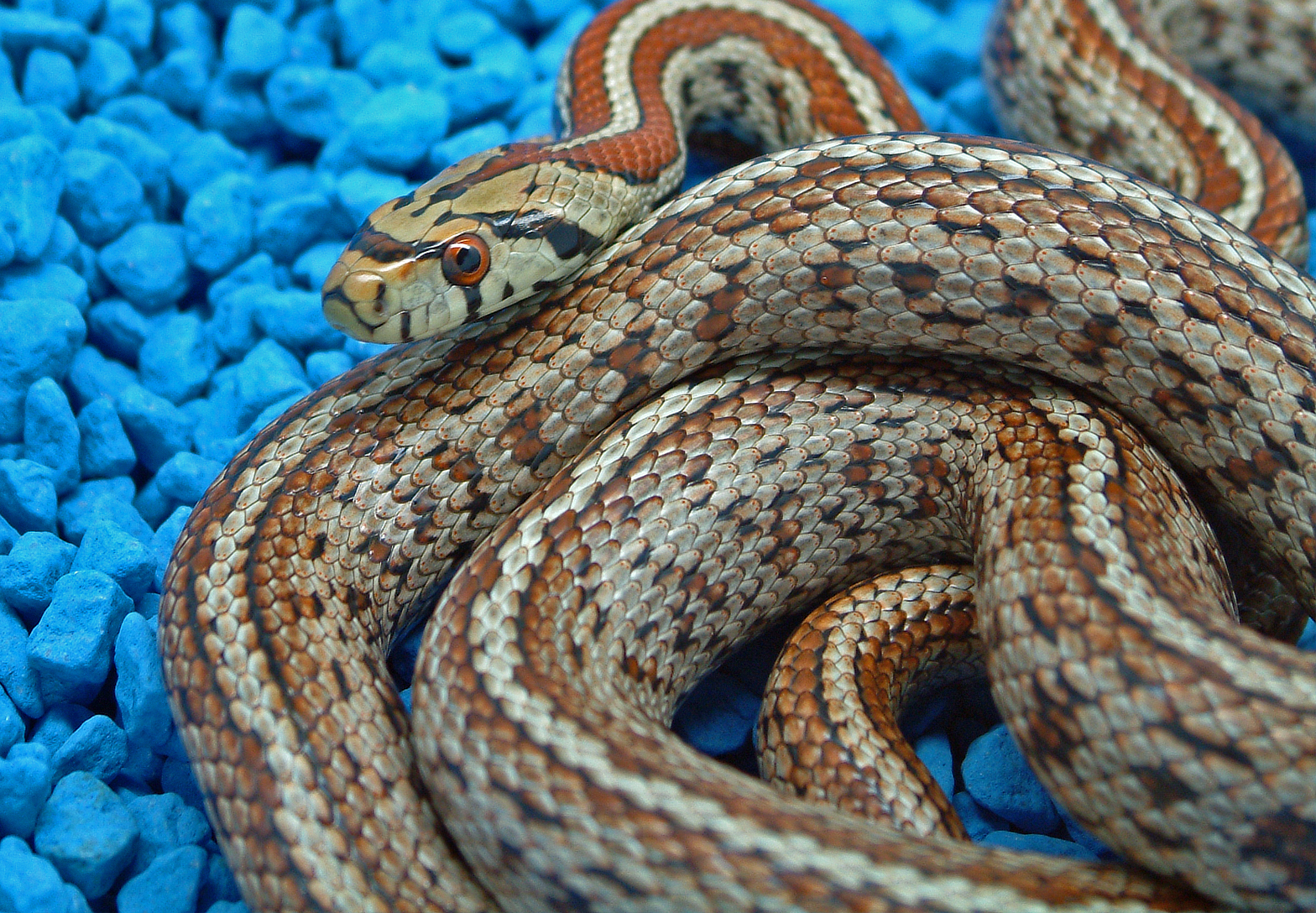
Striped Leopard Snake
(Zamenis situla)

Correct Probe Placement: (Lighting Rig)
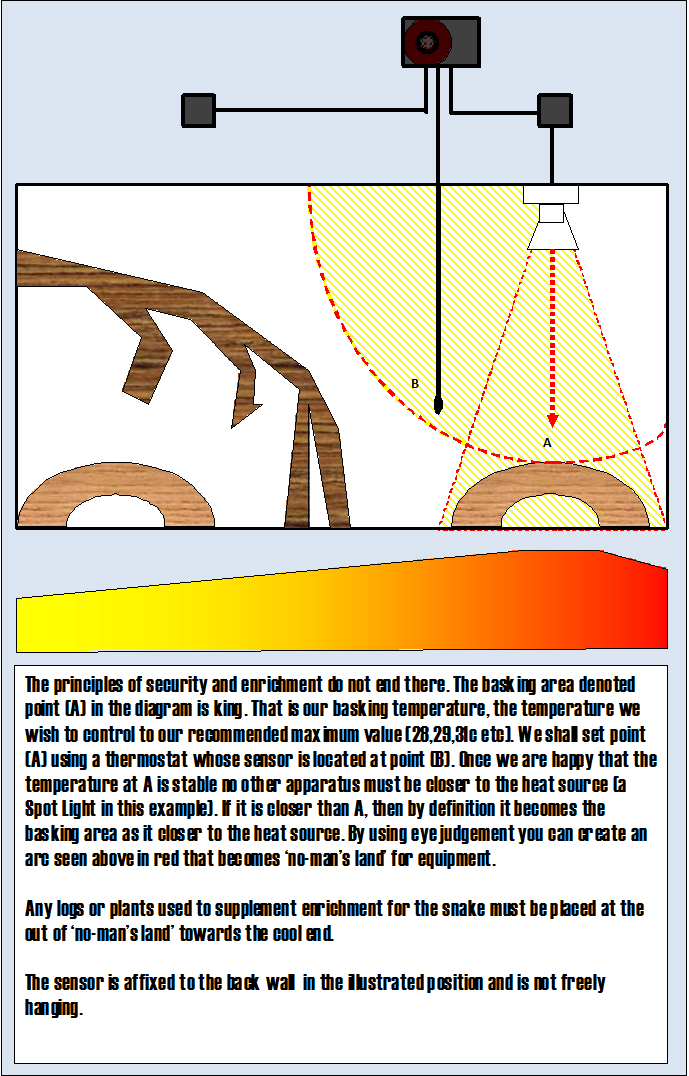
Incorrect Probe Placement: (Lighting rig : 1)
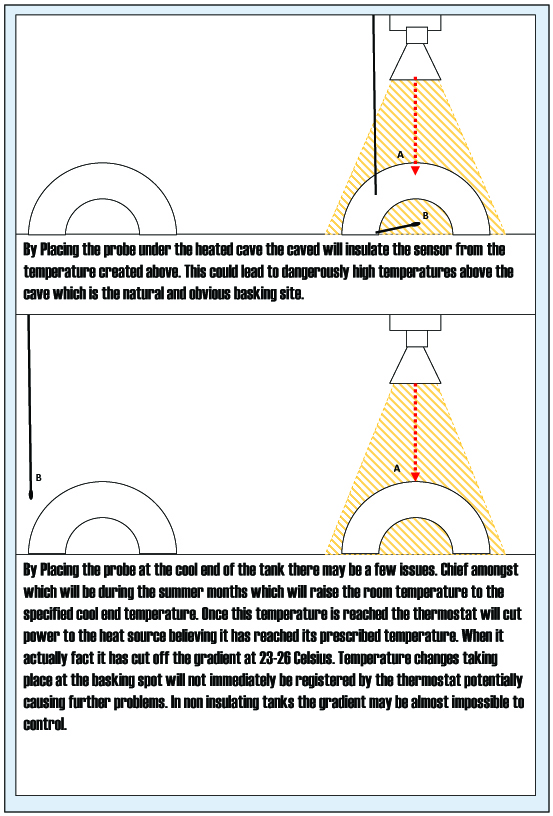
Incorrect Probe Placement : (Lighting Rig : 2)
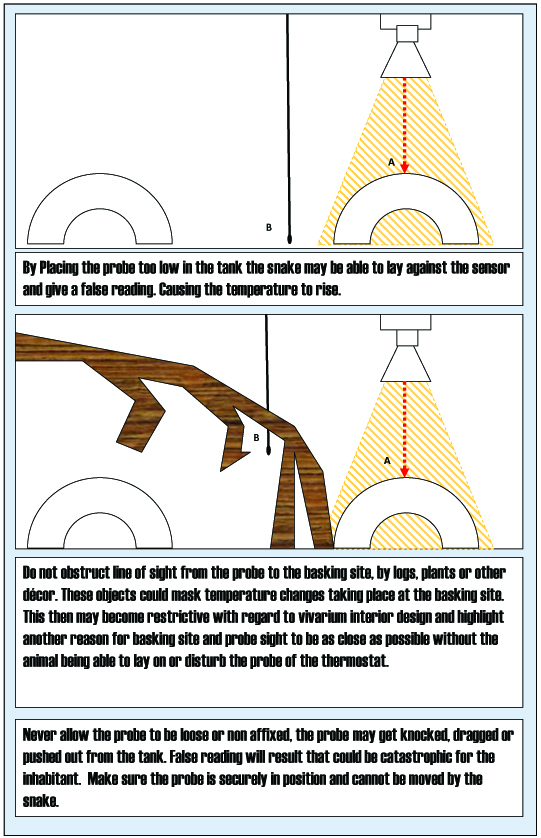
.jpg)
Northern Mexican Pine Snake
(Pituophis deppei jani)
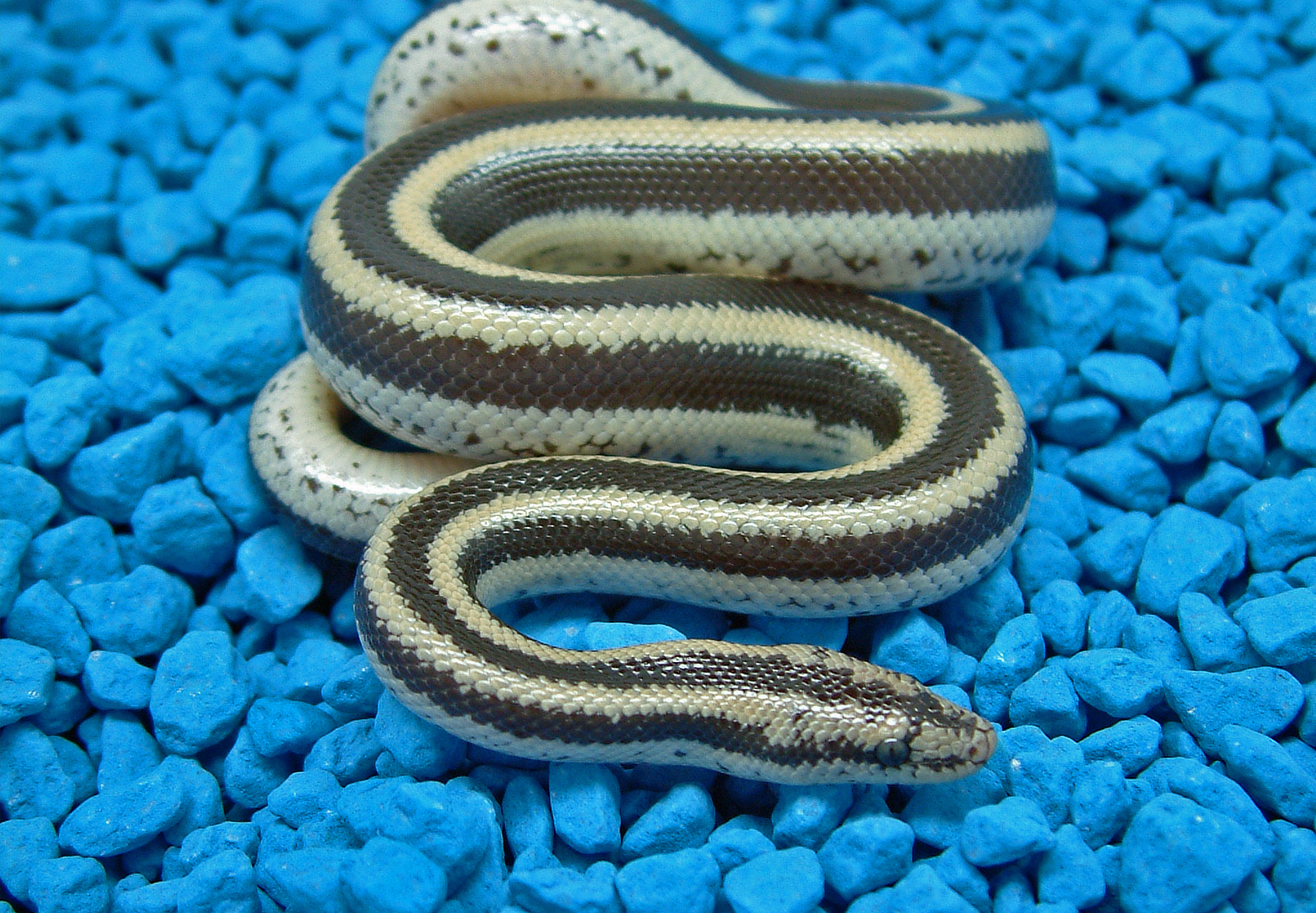
Mexican Rosy Boa
(Lichanura trivirigata trivirigata)
Correct Probe Placement: (Heat Pad Rig)
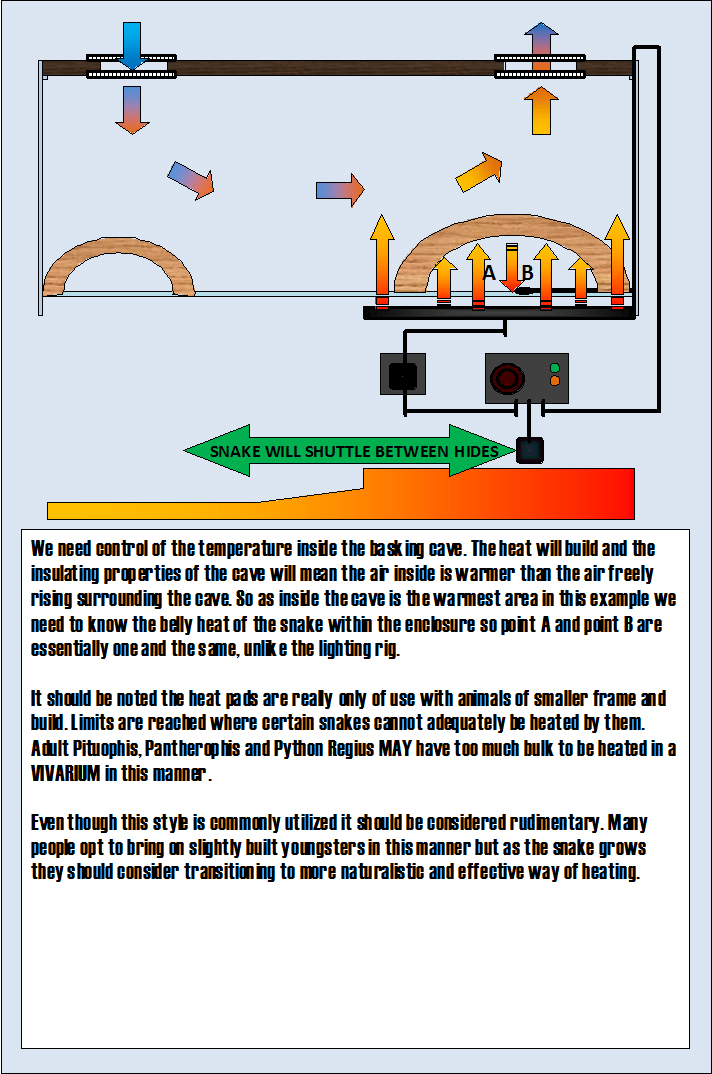
Incorrect Probe Placement : (Heat Pad Rig)
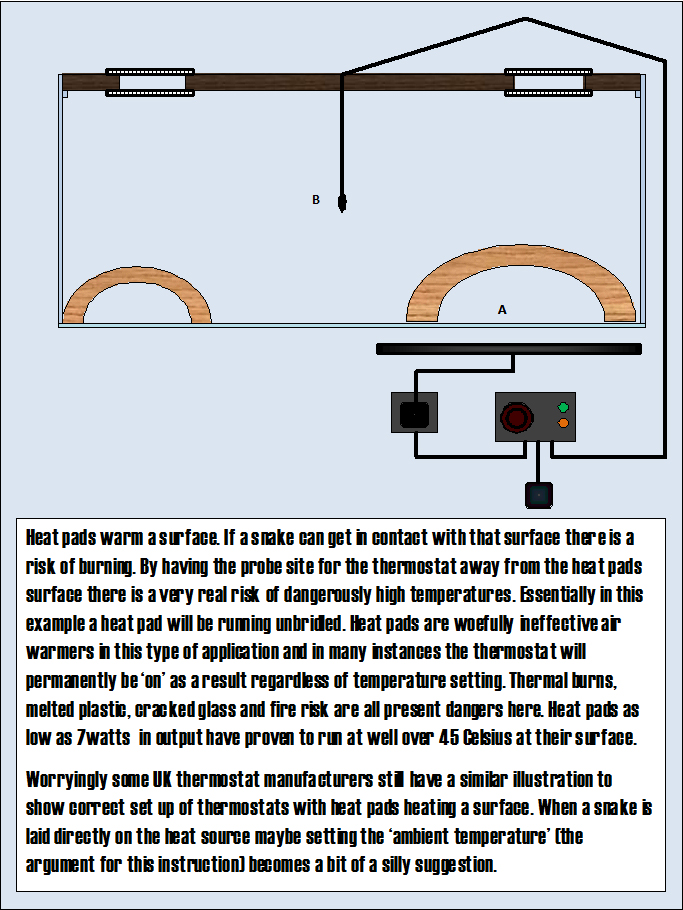
Heat Pads or Heat Mats:
Heat pads are very commonly used and are sourced easily. They may seem expensive when compared to a spot bulb but their price in isolation doesn’t really matter. It is the cost of a heater (whatever type) and an appropriate thermostat to control it. Heat pads can be controlled by the most rudimentary of thermostats making them the cheapest proposition overall. This heater type is at its most useful raising baby snake in crèche type enclosures. Heat pads can come in a range of lengths and it can be easy to have a single pad heating 4,5 or 6 crèche type raising containers for baby snakes. Utilised by a lot of breeders for this reason. If a pad is to be used for multiple snakes there is a golden rule that must be adhered to. All snakes on the pad MUST have the same temperature requirements.
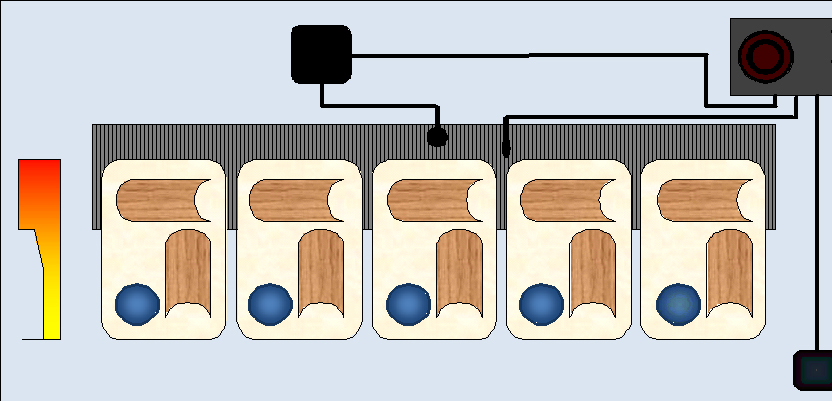
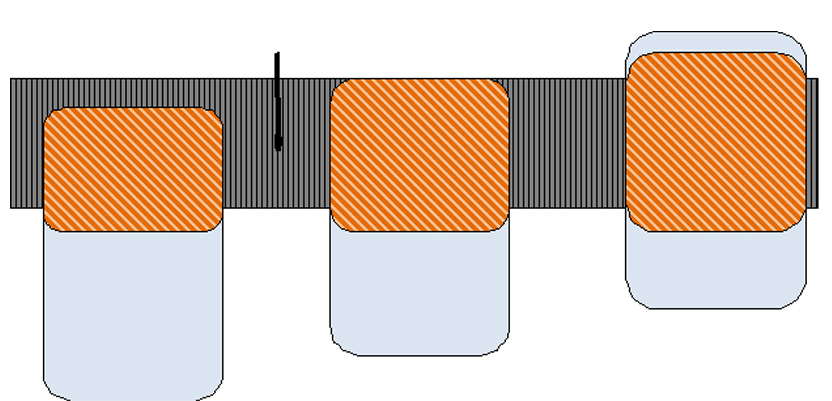
In rack systems the probe from the controlling thermostat should be affixed in between the boxes, a temperature reading can be taken from within the box to set the temperature. Ideally a thermostat should control a single pad, in vertical racks where a single thermostat is responsible for multiple levels this can lead to problematic differences between the levels. Heat rises and as a result every level beneath probe level will run cooler and every one above warmer.
Heat Cable:
Heat cable can be used in two main ways. Multiple passes on a single shelf to re-create the action of a heat pad for animals of a larger build in a rack system. Some systems come with a peg system to wrap the cable in a triangular zig-zag to maximize heated footprint.
The other way heat cable may be used is for hatchling and neonatal racks using much smaller boxes. Each shelf in the rack had a routed track which the cable sits in, the cable weaves through the rack providing heat to each of the shelves. Through basic physics we know heat rises and there is a chance temperature disparities between bottom and top shelf of a rack controlled by a single heat cable. Pay close attention to temperature variance in this kind of setup. If a cable is to be used for multiple snakes all snakes on the cable MUST have the same temperature requirements.
Heat pads are available in different lengths and also available in 5”(Strip) or 11” (Pad) Commonly available sizes of heat pad are:
Strip: Pad:
17”x5” 6”x11”
23”x5” 11”x11”
29”x5” 17”x11”
35”x5” 23”x11”
47”x5” 29”x11”
35”x11”
47”x11”
Heat pads can vary in design and if a rack is to be used where a single thermostat may be responsible for more than one shelf care must be taken to use the same size and manufacturer of pad. Some heat pads use solid conductive cloth design whilst others use strips and waves of conductive heating material. Each will have a heating signature that differs from the other. Expect wattage difference between manufacturers also. Do not try to use heat pads that are either too big or too small for the job in hand. Ideally a heat pad should cover between 33% and 50% of floor surface. Less than this and the snake may not be able to bask effectively. More than this and the gradient may run to warm overall even with thermostatic control (the hot end cold end variance will not be great enough)
When using rack systems think about pad placement to maximize heat distribution. At a certain point the heat strips become non applicable and heat pads are the only solution.
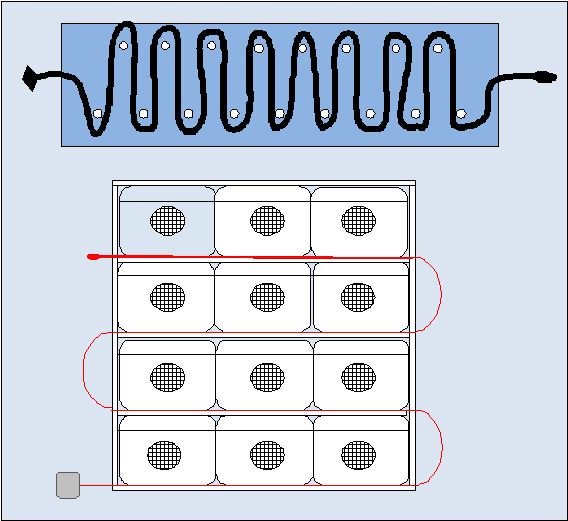
Because of how thin the heat cable is single passes of cable must only be used in baby snake rack systems. Larger snakes will simply not be able to coil themselves properly over the heat source to warm themselves thoroughly. Care must be taken not to route the cable trough too far back in the box. The surrounding wood of the shelf either side of the cable will also warm through slightly so by making sure the cable track is brought forward you can maximise cable efficiency. The only way of effectively heating larger snakes with heat cable is with either multiple parallel passes or the zig-zag technique seen on the previous page.
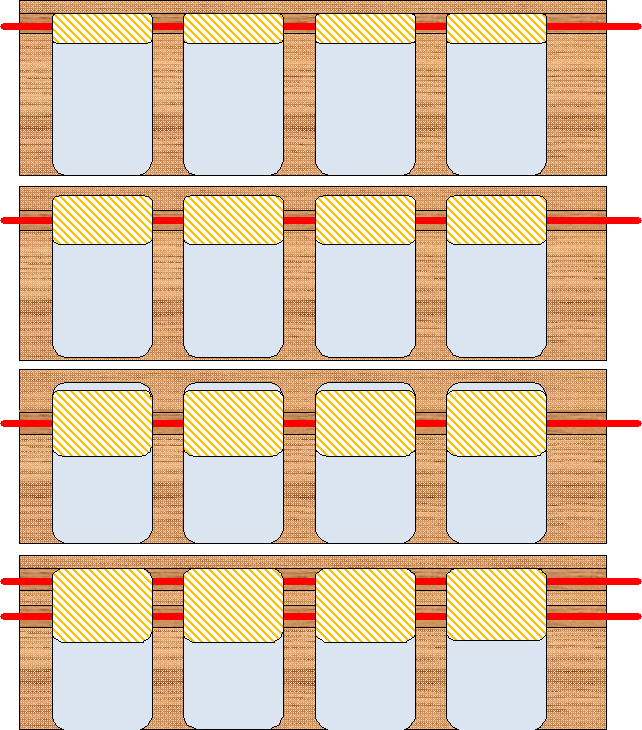
Spot Bulbs:
Whether they are incandescent, halogen, neodymium or otherwise. Whether coloured or clear , their purpose is both to illuminate & heat the surfaces & air at one end of an enclosure. Any enclosed heat source should be controlled by a thermostat. In spot bulbs cases this must be a dimmer or dimming thermostat.
The halogen Hi-Spot and GU10 style spot bulbs have a lot of kick and can be useful for creating super high temperature basking areas (not something which is ALWAYS needed for snakes) If used for snakes covered here, very long life spans are possible as a result of how little they are having to do to heat the tank in comparison to their potential maximum output.
This is also true of incandescent bulbs. These are the cheapest (and also shortest life) bulb usually available from reptile centres. Try to use the most powerful bulb that the fitting can take. The less work the bulb has to do the longer it should last.
Say for example a vivarium takes 30w to heat the basking area to 30 Celsius. A 40w bulb is working at 80% capacity, a 60w bulb is working at 50% capacity and a 100w bulb at 33%. The only real trade off may be that the bulbs slightly dimmer due to the thicker higher wattage bulb filament.
Snakes like all animals have circadian rhythms, it would not be recommended running a clear or frosted (pearl) bulb 24 hours a day. Some work has been done as to whether a coloured bulb running 24 hours is of detriment to a snake if run around the clock on a thermostat (at varying brightness levels, reflective of day and night settings on the thermostat). Many keepers utilize a coloured bulb system although the prevailing trend in the hobby is to separate the heat and light elements. For that we need to move on to the next heater type.
Bear in mind if light emitting bulb are chosen and no light is required at night you would require a second heater in the form of heat pad on a second thermostat potentially doubling expenditure on the heating rig. One therefore ponders if it were such an issue why thermostat manufacturers would even bother with their design of single heat source 24 hour control units? Consider units of this type have been on the British market for in excess of 30 years.
Ceramic Heat Emittor:
This type of bulb comes in different shapes, wattages and applications. Certain manufacturers are trying to replicate the warming action of the Sun by using Infrared – A and Infrared – B wavelengths. The fine detail of which we will move on from and consider these in with the other IR (Infrared) heaters.
These heaters are mounted much like an incandescent bulb within the vivarium at one end (albeit caged, and in a fitting capable of taking the wattage and heat capable from these heaters). They emit no light so are just used for heat. This then simplifies the issue of running a vivarium 24 hours a day at desired temperatures without light contamination affecting sleep and activity patterns.
Infra-red heat emitters are higher value often costing x3-x6 that of the equivalent reptile branded incandescent spot lamps. On the face of it then this may seem like a large expense, but when we look at the lifespan of the heaters it is quite a different picture.
• Incandescent Bulb lifespan = 1000 hours
• Halogen Bulb Lifespan = 2000 hours
• Ceramic Heat Emittor = 10000 hours
• Deep Heat Projector = A claimed 5 year life
This help explains the difference in value, the latter two heaters over the long term representing the far better value for money. Life extensions to Ceramic Heat Emittors are possible. By using the largest bulb possible and allowing it to trickle heat the vivarium will exponentially extend the life of the heater.
Consider that in a ceramic heat emitter rigged vivarium the only light will be the ambient light in the room. On-going research strongly points to the benefits of providing UVB lighting with snakes. This does not need to be high output or intensity but has proven to be beneficial to brain function, activity and colouration. A far larger proportion of snakes are kept under UV lighting than ever before. Previously upon installing a UV source we would have flooded a full vivarium in UV light but new research suggests it should accompany the heater at one end of the enclosure so a UV ‘basking’ area is also provided along side the heat basking area.
Snakes can metabolise the vitamin D3 necessary to create strong bone from the reserves found in the vertebrate prey that they consume. The UV provision is not from a dietary or skeletal consideration more of overall well being and the encouragement of natural behaviours including an increase to thermoregulatory shuttling between ends of the enclosure.
Also worthy of consideration is that many snakes on the market for sale are devoid of much of their natural pigmentation. The natural darker pigments (melanophores) are absent or severely reduced, these pigments protect the snake’s skin and eyes from UV radiation and the suns natural action. In these cases it is not recommended that UV bulbs are used on albino or similar variants.
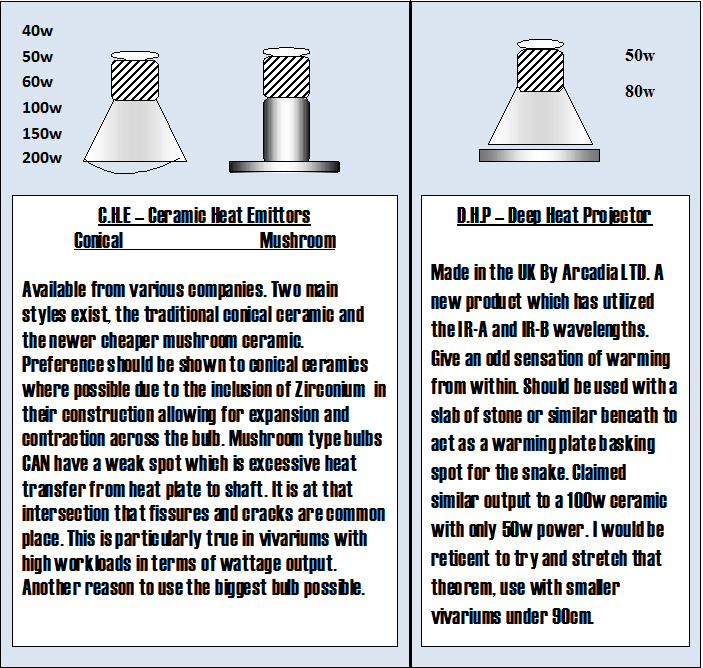

Water & Hydration:
A water bowl should always be provided for your snake. This should be fresh water changed daily. Yorkshire Water where I live has always served me and my snakes well but in regions where water quality may suffer you may have to opt for bottled options. If concerns exist around additives to water allow to stand for 24 hours before use to allow a natural level of dechlorination to take place. Some keepers also opt to use commercial available water filter technologies (such as Brita-filters ™ ). Water bowls should be kept at the cool end of the enclosure away from heat sources to keep it fresher for longer. When it comes to drinking snakes seem to show a real preference for cool, fresh water. Water bowl size can be a bone of contention. Some subscribe to the doctrine that the animal should be able to fully submerge in the bowl others work to the principle that it is better to just be big enough for the head.
IF:
A bowl is to be used or have the usage encouraged as that of a bath it is imperative that the bowl is oversized. The bowl must be never more than half filled to avoid spillages. Repeated spillages in wooden enclosures will quickly blow joints and cause them to rot.
IF:
A bowl is to be only used as a drinking vessel and bathing therefore dissuaded care and thought must be given to alternative ways of softening or conditioning the snake’s skin. This will most likely take the shape of a damp box or moist hide. Even obligate arid species will still have access to higher levels on humidity in nature by utilizing burrows and cave networks that take them nearer the water level. At no time is this availability of greater importance than when a snake is going through a shed cycle. Many snakes will utilize a bath or damp box to help them. If bad, bitty shed become common place then a lack of humidity is the problem.
On a side note when considering a snakes shed cycle it is also worthy considering how damp a house naturally is. My 1905 mid terrace single skin brick built house suffers with damp, modern breeze block built houses are bone dry. I have never had a bad shed at my house but people in modern homes may find their air is too arid even for dry climate species.

Solid State:
Newspaper:
• Usually free or used.
• Ugly
• Stains animals, tubs and vivariums
• Not particularly absorbent
• Grafts to plastics, wood and glass
• Doubles up as a hide
Kitchen Towel:
• Neutral white or pastel colours, shows up mites.
• Absorbent
• Doubles as a hide
• Low cost
Corrugated Card:
• Reasonably attractive when new and clean
• Reasonably absorbent
• May graft to surfaces once wet
• Usually only available in huge reams
• Costly in ream form
• Storage or spare ream will require a lot of space
Artificial Grass:
• Attractive when clean
• Not absorbent
• Discolours easily
• Can be costly, may be hard to source.
• Spares required whilst soiled item cleaned, multiple tanks = multiple spares
• Hard to clean thoroughly
Pseudo-Naturalistic:
Aspen / Aubiose:
• Attractive when clean and dry
• Absorbent
• Very dusty (not for asthma sufferers)
• Rots easily when wet (arid species only)
• Mid-Range Cost
Lignocel:
• Smaller grade flake/chip than Aspen
• Highly absorbent
• Manufacture includes extraction process (far less dust)
• Does not rot easily when wet
• Widest range of application for species covered here of any Pseudo-naturalistic substrate.
• Mid-Range Cost
Beech Chippings:
• Been used in the hobby for decades
• Looks great when clean & dry
• Absorbent
• Some dust but not excessive
• Rots easily when wet (arid species only)
• Mid-Range Cost
Orchid Bark / Cypress Mulch:
• Been used in the hobby for decades
• Absorbent
• Can be quite dusty when dry
• Does not rot easily
• Used almost exclusively for more humid species
• Mid-Range Cost
Corn Cob / Ground Nuts:
• Natural by-product
• Digestible (supposedly)
• Absorbent
• No real dust issues
• Rots rapidly when moistened
• Exclusively only for arid species (limited applications here)
• High cost
Coir / Coco Fibre:
• Natural by-product
• Absorbent
• Dusty when dry
• Does not rot easily
• Used almost exclusively for humid species
• Mid-Range cost
Particulate Mixes: Bioactive and Non-Bioactive
• Available as shop bought mixes
• Can be mixed at home using component substrates
• Absorbent
• Can be dusty when dry
• Does not rot easily
• Mix changes depending upon habitat (incredibly flexible as a result)
• Can be costly as shop bought product to fill a larger enclosure.
• Due to cost and/or presence of isopods in bio-active enclosures temptation may be there to leave in longer than with other substrates. Odour may prove problematic long term.
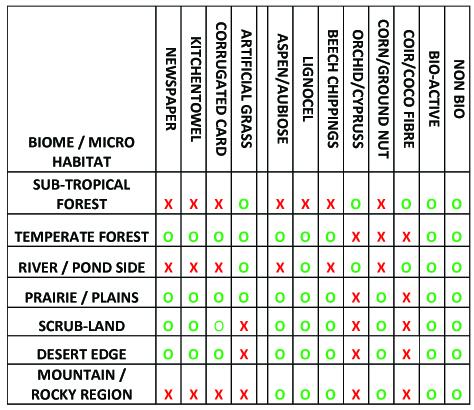
Any loose substrate can be ingested. It does not matter what the substrate is, if it is in particulate form it can be swallowed by a snake. Inherent issues arise here, where impaction and tears to soft tissues can occur. Solid state floor coverings cannot easily be ingested but they do not allow a snake to burrow. And so an impasse is reached. Worry not there isn’t really a right or wrong answer apart from using wet substrates for dry species and visa versa. The rest is conjecture (personal opinion) choose what you can make the most logical sense out of. Maybe work your way through 2 or 3 over the course of a few months to see which one you like working with the best and which the snake does not seem to mind. Remember these decisions are not final, this is the journey. Learning what works and what doesn’t, what feels right and what doesn’t. It isn’t all set in stone and to have a personal preference is fine. There are many choices and options for each biome type.

Décor and Apparatus:
Depending upon the biome or microhabitat of a snake the décor and other equipment used will change. Of course there are elements of interchangeable nature. Decisions made regarding what to use to decorate a vivarium is down to you same as choosing your substrate of choice. The only fixed rules we have covered already :
• A hide at either end
• A no man’s land area for décor or apparatus closer to the heat source than the basking area (when we use an overhead heat source)
• Water bowl at the cool end
That’s it! – The rest is up to you. Some keepers stay true as possible to nature, others use their own aesthetic compass which can lead to interesting interpretations of enclosure design. But it isn’t this books job to do the design and construction of vivarium internals for you, after all that’s one of the fun jobs. The three rules have mechanical reasons for the husbandry and welfare of your snake. A hide is a hide. A hides mechanical job is to provide cover and obstruct line of sight directly onto the snake. A snake recognizes seclusion whether that be a top of the line resin stone effect reptile cave or a used cereal box. Mechanically they are identical, aesthetics are the only difference. Aesthetics, simply are not always a primary driver when it comes to snake care. For some keepers it is, and that’s fine but as long as the simplistic enclosure has met it’s mechanical responsibilities by provided multiple hide sites and a cool bowl of water to enjoy what’s the problem? Hilariously people with the biggest problem seem to forget if you went snake hunting in Florida and there was a rotten log or an old car tyre I know which I would lift first in the hopes of striking snake gold and it wouldn’t be the log. It is imperative as keepers we have to remember it is different strokes for different folks.
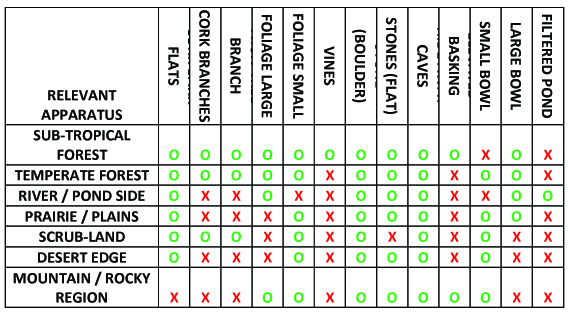
Live plants:
This is not a website on botany so I will only pay lip service to this subject here. Plants require light. Some plants require masses of light. Many plants if not provided with adequate light will etiolate or stretch to find whatever light is provided. This ruins plants. Many keepers under estimate just how much light is required to keep them in a healthy state of repair. Plants require time to root, this leads to lead time, this leads to delays. Plants require water, depending on species sometimes a lot of water. Will this effect internal humidity levels for the snake? Arid species of plant require masses and masses of light. Certain succulents will still etiolate in direct UK sunlight! Certain shade dwelling plants may fair reasonably well when grown in isolation in a vivarium ferns, bromeliads, ivys etc. When you then place a boisterous snake in there who has zero respect for your hard work welcome to a head ache. Those that want to do it will. Its personal preference.
